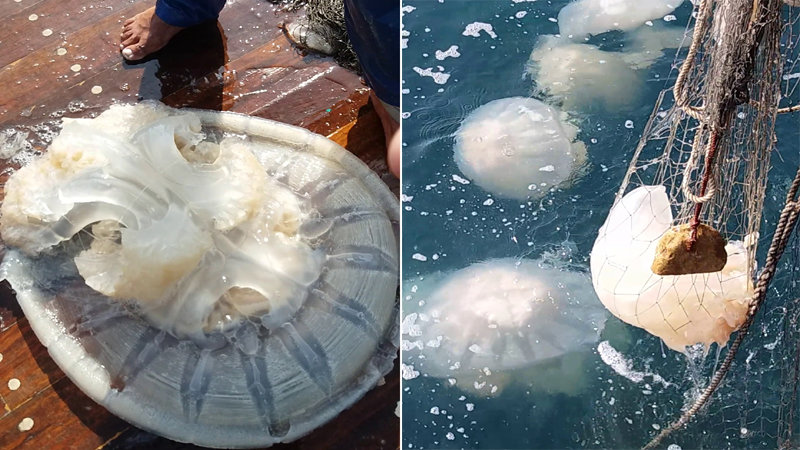
Unusual jellyfish blooms affecting fishing activities in coastal areas
Local fishermen have reported unprecedented jellyfish blooms in the offshore waters of Pakistan which are affecting fishing activities.
During the past fortnight, blooms of the mauve stinger (scientifically known as
Pelagia noctiluca) have been observed in the continental shelf along the Sindh and Balochistan coasts.
Large aggregations of this stinging jellyfish, which are mauve to magenta in colour, have been reported in offshore waters of Karachi to the Indus Swatch (some 140km south of Karachi) and Ormara.
WWF-Pakistan studies revealed a population of more than 150 individuals per cubic metre, which is clogging the fishermen's nets. Its eight tentacles carry stinging cells known as cnidocytes.
Within these cells are harpoon-like structures full of venom, called nematocysts, which shoot out when triggered by touch and can penetrate human skin. Jellyfish is locally known as 'Langara' in Sindhi and 'Mus' in Balochi.
Pelagia noctiluca is well-known for beautiful luminescence and glittering in the night when disturbed or moved by wave action.
Luminescence in sea has been reported by fishermen during the past two weeks.Due to the high density of this jellyfish, fishing activities have been affected in those areas, resulting in clogging of the nets. Moreover, handling or removing this jellyfish from the nets can inflict severe and painful stings. Once affected, the pain lasts for more than 24 hours and results in the inflammation of the skin.
Fishermen involved in gillnetting and other fishing operations have decided to move to other areas, mainly to Sonmiani Bay and adjacent waters. Sudden decrease in catching some prime fish has been attributed to the jellyfish bloom.
Trained by WWF-P, fisherman Falak Niaz pointed out that this luminescent bloom was spread over an area of about 250 square kilometres in the offshore waters, but was declining. "Previously, such blooms in Pakistan were observed to last about 10 to 20 days. There is no commercial importance of this jellyfish."
In further offshore waters near the Indus Swatch, another bloom of mammoth jellyfish commonly called mushroom jellyfish (scientifically known as Rhopilema hispidum) has been reported.The population of this large jellyfish surged during the second week of December and continued until the filing of this report. In some of the areas their numbers were so large that fishermen decided to stop fishing.
This jellyfish species is very large in size and disentangling it from the net and throwing it back into the sea is a cumbersome process and has to be done carefully due to its painful stings.
Locally known as 'Jungli langara', it is of commercial importance. It is harvested in creek areas of Sindh by using set bag nets, surface gillnets and encircling gears.
Jellyfish are also commercially harvested in Pakistan for export purposes. Annually about 2,500 million tonnes of dried jellyfish is exported.
Rhopilema hispidum and
Catostylus perezi are two dominating species which are being processed and exported from Pakistan.
The highest jellyfish export was noticed between 2005 and 2007 when annually about 4,000 million tonnes of jellyfish products were exported to China and Vietnam. There are some 15 permanent and 35 temporary facilities along the Pakistani coast. Main processing plants are located in Ibrahim Hyderi, Rehri and Keti Bunder in Sindh and Damb along Balochistan's coast.
Target harvesting is being carried out in Damb and Kalmat in Balochistan and the creek areas of Sindh, whereas large quantities are also harvested through set bag net ('bhulla') in the creek areas and by gillnets in Damb.
Jellyfish legs (tentacles) are treated with salt and alum solution and the semi-dried end product is exported. Jellyfish fisheries in Pakistan supplement as an extra source of income for small-scale fisheries in the coastal areas of the country. It is estimated that more than 10,000 people are engaged in jellyfish fisheries in Pakistan.
While there have been reports of large jellyfish blooms in Pakistan, in December 2002 a massive bloom had occurred along the entire coast of the country.
A large number of
Crambionella orsini have resulted in decreased catch of commercial fishing operations along the coast of Pakistan. It has resulted in massive clogging of nets and interrupted the operation of the seawater cooling systems of the coastal power plants and ships. A number of smaller blooms frequently occur in Pakistan but these do not pose any threat to fishing and other operations.
WWF-P Marine Fisheries Technical Adviser Muhammad Moazzam Khan pointed out that the frequency of jellyfish blooms was increasing in Pakistan, like many other parts of the world. Such blooms, according to him, disrupt the fishing industry by tearing nets and clogging cooling water intakes at power plants, causing power reductions or shutdowns.
There are reports that jellyfish blooms can reduce the population of the commercially important fish by eating the zooplankton and consuming their eggs, larvae and juveniles.In 2009 a fishing trawler capsized as the crew tried to pull in nets filled with jellyfish in Japan. Jellyfish sting swimmers, therefore, may discourage tourism in some areas.
Khan said that despite all the circumstantial evidences, scientists acknowledge the need for more research to determine conclusively if jellyfish blooms are a function of natural cycles or the result of human impacts on the environment.
Jellyfish blooms, according to him, feed on plankton, crustaceans, small fish and fish eggs; therefore, they deplete the food resources of fish and larger mammals like whales. He emphasised the need for conducting research on causes of bloom formation by jellyfish.
Reader Comments
to our Newsletter